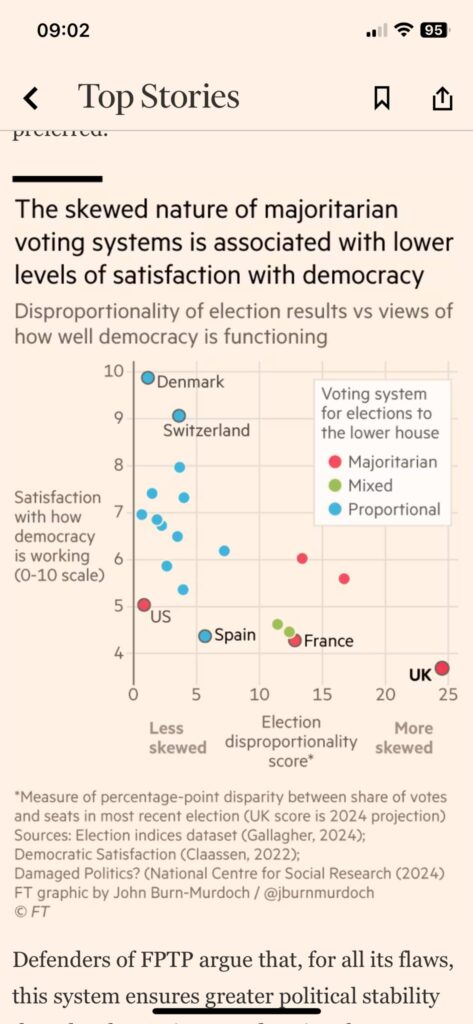Sainte-Laguë with personal votes
In the aftermath of the UK General Election of 2024, there’s been a lot of talk about introducing Proportional Representation (PR) because of the way Labour won two-thirds of the seats with only a third of the votes. Many are seeking a fairer and more representative system, so here is a concrete suggestion inspired by the Danish model. While the Danish system adds a lot of bells and whistles to make it even more proportional, I believe simplicity is of value, too. Let’s call my proposal Sainte-Laguë with personal votes.

So how does it work? To start with, let’s keep the existing constituencies but group them for the purposes of elections. For instance, Glasgow’s six constituencies could be combined with Rutherglen and Coatbridge & Bellshill to form an eight-seat group. This method allows for a more proportionate representation while maintaining local ties and requires no alterations to current candidate selection processes.
The ballot papers will be longer, listing all candidates within the constituency group, with the local candidate appearing first. Each party will have up to eight candidates on the ballot paper (in an eight-seat constituency group), and voters will mark their preferred candidate with an X.
Once votes are cast, they are counted for each party collectively. The Sainte-Laguë method, similar to the d’Hondt system but dividing votes by 1 – 3 – 5 – 7, rather than 1 – 2 – 3 – 4, is used because it results in a more proportional outcome.
To decide which candidates get elected from each party, we count the votes for each candidate and allocate seats to those with the most votes. This ensures that the most popular candidates within each party represent their constituencies.
Using our example, the election results would be as follows if the use the votes cast last Thursday:
- Labour: 4 seats
- Michael Shanks (21,460 votes)
- Frank McNally (19,291 votes)
- Patricia Ferguson (18,621 votes)
- Gordon McKee (17,696 votes)
- SNP: 3 seats
- Stewart McDonald (13,542 votes)
- Steven Bonnar (12,947 votes)
- Katy Loudon (12,693 votes)
- Scottish Green: 1 seat
- Niall Christie (5,554 votes)
Of course, in reality voters would start voting very differently when tactical voting is no longer a necessity and they know their vote will be important.
 This system is likely to lead to greater satisfaction with the electoral process. It’s straightforward, maintains local political connections and offers significant influence to the voters. It’s a system that balances proportionality with simplicity, providing a clear and fair representation of the electorate’s will.
This system is likely to lead to greater satisfaction with the electoral process. It’s straightforward, maintains local political connections and offers significant influence to the voters. It’s a system that balances proportionality with simplicity, providing a clear and fair representation of the electorate’s will.
There was a graph in the FT showing that Danes are the happiest with their system. My proposal is similar, and is therefore likely to lead to a similar result in the UK, resulting in a healthier democratic process and making it more equitable and reflective of the diverse political views within the country. It’s a change worth considering for a more representative and satisfied electorate.
I’ve written a small program to simulate my system. (I grouped the constituencies a bit randomly, but that shouldn’t result in any major changes to the over-all result.) Here are the FPTP results, my proposal and percentage-based votes (where you get n percent of the seats if you win n % of the votes) – see also the pie chart above:
| Party | Result | Proposal | %-based |
|---|---|---|---|
| Labour | 411 | 232 | 225 |
| Conservative | 121 | 158 | 159 |
| Reform UK | 5 | 86 | 96 |
| Liberal Democrat | 72 | 81 | 81 |
| Green (E&W + Sc.) | 4 | 52 | 45 |
| Scottish National Party | 9 | 16 | 16 |
| Plaid Cymru | 4 | 5 | 5 |
| Sinn Fein | 7 | 5 | 5 |
| Democratic Unionist Party | 5 | 4 | 4 |
| Alliance Party | 1 | 3 | 3 |
| Social Democratic & Labour Party | 2 | 2 | 2 |
| Traditional Unionist Voice | 1 | 2 | 1 |
| Ulster Unionist Party | 1 | 2 | 2 |
| Workers Party of Britain | 0 | 1 | 5 |